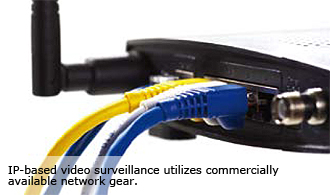In our world of smart phones, HDTV and the “Web 2.0” Internet, everyone is alternately delighted and annoyed, empowered and confused given the rapid changes in technology in our daily lives. Gadgets and online tools that seem cutting-edge when launched often become obsolete shortly after their releases. That familiar fast-paced pattern in the world of consumer electronics can provide some understanding of the nature of the changes underway in the more conservative security industry.
In our world of smart phones, HDTV and the “Web 2.0” Internet, everyone is alternately delighted and annoyed, empowered and confused given the rapid changes in technology in our daily lives. Gadgets and online tools that seem cutting-edge when launched often become obsolete shortly after their releases. That familiar fast-paced pattern in the world of consumer electronics can provide some understanding of the nature of the changes underway in the more conservative security industry.
Most industry insiders are familiar with the confusion in the minds of buyers and decision makers regarding newer surveillance technologies. While standards for broadcast television and CCTV evolved slowly, things in the world of computers and IT move at a much faster pace. The computer literacy of a large segment of the security installer community lags behind some other more high-tech industries; meanwhile, the innovation train keeps on rolling. In the information age, the standards and methods for capturing, transmitting, viewing and recording actionable surveillance video are forever in a state of flux.
The reality is that an experienced CCTV professional (call him “Art”) just may not have reached a sufficient comfort level with network cameras and NVR software. Art knows that he can deliver good results to his clients using analog cameras and DVRs or even — gasp — VCRs. Why would Art risk his business on a new approach? What probably comes to mind involves generalpurpose business applications crashing his PC.
Now, Art probably has a pretty decent HDTV at home. Art may even use VoIP telephone service at home, and he probably has at least tried using Skype video conferencing at work if he does business internationally and is looking to save. Every day, Art is tied to his PC and his BlackBerry/ iPhone, and he has come to accept these as indispensible tools in his work. Indeed, his customers and coworkers expect the flexibility and capability of urgent access that mobile devices provide.
Art must have some pretty good reasons for his specific discomfort around offering IP-based surveillance solutions in his business. Perhaps Art has already tried a network camera solution on a smaller, lower-risk project but he got burned. Art may be gun-shy after a bad experience that involved too much time spent on product selection and troubleshooting. Or perhaps Art is standing by smugly and watching one of his old buddies (read “a competitor”) go through some of the same struggles.
The famous “fear, uncertainty and doubt,” or FUD, only make Art human. FUD is typically the No. 1 factor preventing someone who is not an early adopter or tech junkie from trying out the next big thing. However, Art's FUD is probably what is holding back the future of his business in the next year or two. It is more likely that Art is just climbing the industry-specific learning curve, concerned about reliability and scared of losing face in front of his customers.
New “Definitions”
The table accompanying this article compares and contrasts the capabilities and challenges involved in each of the video formats. In recent times, the categories of “HD” and “IP” have been blurred. This is largely because many network camera manufacturers are seeking to link “scary” megapixel cameras with the more “friendly” HDTV technology found in our homes. Network cameras come in various forms, with image sensors ranging from SD/VGA up to the same multimegapixel resolutions found in point-and-shoot digital still cameras.
“Old school” SD CCTV
 SD CCTV technology is more established and the more comfortable option for those without specialized IT skills. Conventional analog cameras use coaxial cables to carry video signals from cameras to displays and recorders. Analog/SD systems will probably always be the system of choice for many small retail and home systems.
SD CCTV technology is more established and the more comfortable option for those without specialized IT skills. Conventional analog cameras use coaxial cables to carry video signals from cameras to displays and recorders. Analog/SD systems will probably always be the system of choice for many small retail and home systems.
The highest analog CCTV resolution is D1/4CIF. This category covers the varying broadcast standards found across the globe, NTSC and PAL/SECAM, all approximately 700 pixels wide by 500 lines. Even today, one can still find installations at appallingly low resolutions such as CIF (352 by 288) and QCIF (176 by 144).
It is now more common to see NTSC, for example, expressed as 486i30, which denotes 480 lines, 60 interlaced odd and even line fields per second, at 30 complete fps. Similarly, PAL and SECAM can be referred to as 576i25.
In all cases, the SD/analog video signal formats are constrained in order to maintain compatibility with legacy transmission methods and the requirements for scanning in older CRT monitors. To understand what happens if you break with the analog video format, the older readers among us need only recall what happened when you took an old TV and altered the vertical hold or horizontal hold. One would find that bands and diagonal patterns ran through a badly garbled, unrecognizable image. To avoid this kind of breakdown in image quality,professional installers use specialized analyzers to make sure that the analog video signal matches expectations for signal levels and sync pulses that are required to transmit and display clear images.
Rise of Net-Centric Cameras
Network cameras require some new learning on the part of industry veterans. There are new skill sets involved in order to successfully deploy edge devices and networks, as well as new VMS software that performs the functions of recording, playback and storage. In the field of higher education, for example, it is now commonplace for an IT administrator to partner with the head of campus security in a specifying a solution.
Having emerged in the last 10 to 15 years, network cameras are most likely to be found in new or “greenfield” sites, such as schools, colleges, office buildings or airport terminals that already benefit from earlier investments in network cabling or wireless links. Such facilities are ripe for an upgrade to IP-based surveillance systems as soon as the budget becomes available.
Network cameras connect directly to the network and function autonomously, continually transmitting images to a host computer. Image and control data is sent over the same low-cost Cat-5e unshielded twisted pair cable commonly found in office datacom applications. As with analog systems, conversion to optical fiber-based transmission is available where there is a desire to run long cable spans without electromagnetic interference.
Most network cameras offer equivalents of VGA (640 by 480) and D1, but a growing number are megapixel cameras. The most common megapixel resolutions are:
● 1 megapixel
○ SXGA: 1,280 by 1,024 pixels, 4:3 aspect ratio; or
○ 720p HD: 1,280 by 720 pixels, 16:9 aspect ratio
● 2 megapixels
○ UXGA: 1,600 by 1,200.pixels, 4:3 aspect ratio; or
○ 1,080p HD: 1,920 by 1,080 pixels, 16:9 aspect ratio
The main advantage of megapixel systems is that they increase the number of pixels on the subject. One can maintain much higher image fidelity when performing a digital zoom-in on a person of interest, the license plate of a vehicle or known problem areas.
Network and megapixel cameras can also remove some of the temptation to deploy dummy cameras or leave IP-based video surveillance utilizes commercially available network gear. VIEWPOINT 322 AUG 2010 www.asmag.com 22 entire areas without surveillance. A VMS/NVR softwarebased system can be extended by adding additional licenses to support more cameras. A system with analog cameras running into a 16-channel DVR is probably great, until one needs to install a 17th camera!
 It is also possible to crop a megapixel image to an unusual aspect ratio, to exclude, for example, irrelevant areas of the sky or to preserve the privacy of a neighboring residence. By digitally cropping the image in the camera, the system integrator can usually boost the frame rate while saving on image size, reining in the network bandwidth and data storage requirements.
It is also possible to crop a megapixel image to an unusual aspect ratio, to exclude, for example, irrelevant areas of the sky or to preserve the privacy of a neighboring residence. By digitally cropping the image in the camera, the system integrator can usually boost the frame rate while saving on image size, reining in the network bandwidth and data storage requirements.
Other ways to lower bandwidth and storage requirements involve moving from M-JPEG full-frame encoding of images to a streaming media codec such as H.264/ AVC/MPEG-4 Part 10 or the earlier MPEG-4 Part 2. H.264 and its cousins are distinguished by transmitting fewer complete frames. Each complete frame is followed by a series of images derived from updates that represent the most significant changes to the scene.
Network cameras generally incorporate password protection, motion detection, on-screen time/text, privacy mask zones and other configurable features. Camera setup or adjustment by an authorized administrator can be performed either on-site or remotely using a computer with access to the surveillance network. Another big payoff for IP-based systems is the easy scalability to large deployments. More and more VMS providers provide side-by-side integration of surveillance functions with IP-based systems for access control and alarms.
Compared to earlier technologies, network cameras are also easier to extend or repurpose, for parking and traffic surveillance (including ALPR), people tracking, face finding and other forms of video content analysis. There is likely an available upgrade to your VMS and/or your camera, with some training required to learn the tips and tricks needed to optimize the new tools.
As with any new technology, there are trade-offs involved in moving from analog CCTV to IP video. The most commonly cited barrier is the computer, networking or “IT” skill set discussed previously. In addition, many analog CCTV advocates are disappointed in the low-light performance or overall image quality of some network cameras. However, this perception is largely due to the selection of low-end cameras based on very inexpensive CMOS sensors designed mainly for camera phones.
Another difference found in network cameras relative to analog CCTV is a lower frame rate for display. The frame rate in operation will depend on a combination of factors. The image resolution has an effect, so that multimegapixel cameras may refresh more slowly depending on the size of the image files being transmitted and the capture rate of the image sensor in the camera. The encoding type also has an effect. H.264/MPEG-4 can transmit more frames per second, since they perform more and different data compression. M-JPEG compression, on the other hand, generally provide higher image quality, especially for digital zoom and for highly changeable environments. However, the transmitted frame rate for M-JPEG encoding may be lower and the bandwidth and storage requirements will be higher for multimegapixel cameras when compared to H.264.

HDcctv Alliance: Back to the future?
There is another category of surveillance systems coming to market that is more strictly speaking “HD” in the sense of HDTV that we are familiar with in our homes. The HDcctv Alliance technology is an emerging system of cameras and DVRs that offer a middle ground between SD/analog CCTV and megapixel cameras.
The new HDcctv cameras, encoders and DVRs now being announced are expected to have a large penetration in cost-sensitive applications, such as small- or mediumsized retail and residential surveillance. While lowering the bar in terms of specialized skills for installation and service, not to mention the associated costs, HDcctv gear seeks to set a new standard for the image quality relative to earlier SD/analog systems.
What's Next?
Given the rapid pace of technological change in the world of computer and imaging technology, it can be difficult to understand what might be around the corner in just a few years' time. One of the lessons of media theory is that no technological transformation is ever complete. It is typical to find new and old technologies existing alongside each other for long periods of time, each filling its particular niche. McLuhan's concept of a tetrad of media effects suggests that each new medium enhances, obsolesces, retrieves and reverses what came before.
At present, network cameras are growing in importance, enhancing resolution, remote access and configurability. Increasingly, VMS takes over the role of the “TV audience,” recording the images and interactively aiding control room personnel. For investigators, VMS also enables better postincident analysis with intuitive tools for searching, looping, pausing and digitally zooming.
Network cameras are also obsolescing analog video formats in large-scale installations, but not in cost-sensitive applications like small retail shops where a basic deterrent is all the user requires. Network cameras retrieve some of the high-resolution attributes of earlier film-based and digital still cameras.
Finally, network cameras reverse earlier trends involving CCTV installations comprising repurposed broadcast television in a lower-cost, lower-quality form. That older CCTV paradigm included expectations for control center staff and security guards to behave as the audience for particularly boring TV programs where it is rare for important events to occur.
 Only time will tell to what extent the new HDcctv Alliance will reverse part of the network camera technology and attributes. HDcctv may remove much of the need for a networking/computer skill set. This is expected to appeal to the segment of the market comprised of smaller installations where scalability and advanced functions are not very important. Furthermore, the new HDcctv might just retrieve some of the old SD/ analog CCTV to all of those old-school installers. Relative to SD CCTV, HDcctv will certainly serve to enhance image quality. Both network cameras and HDcctv will continue to obsolesce SD and lower resolutions as acceptable formats for legal proceedings.
Only time will tell to what extent the new HDcctv Alliance will reverse part of the network camera technology and attributes. HDcctv may remove much of the need for a networking/computer skill set. This is expected to appeal to the segment of the market comprised of smaller installations where scalability and advanced functions are not very important. Furthermore, the new HDcctv might just retrieve some of the old SD/ analog CCTV to all of those old-school installers. Relative to SD CCTV, HDcctv will certainly serve to enhance image quality. Both network cameras and HDcctv will continue to obsolesce SD and lower resolutions as acceptable formats for legal proceedings.
According to the International Technology Road Map for Semiconductors, Moore's Law's pace is coming to an end, with some classes of devices scaling down to every three years. The semiconductor industry may need to explore new device concepts, new materials and nanotechnology. In such times, companies will need to keep an eye on R&D spending while emphasizing efficiencies to stay competitive.
In a competitive environment, we can still expect to see more powerful devices of every description, just not at the same bargain prices. Luckily, we seem to have no shortage of digital imaging technology options to work with today to fulfill just about any mission in the world of video surveillance.